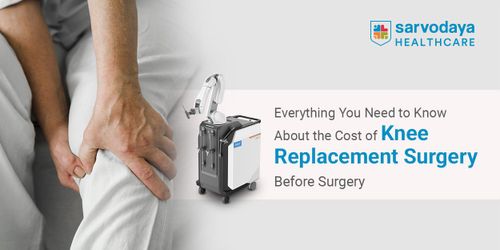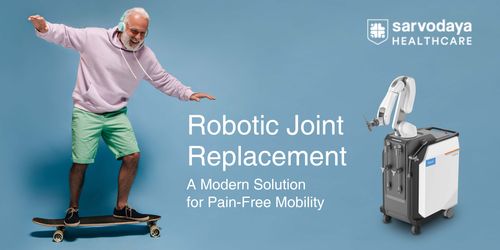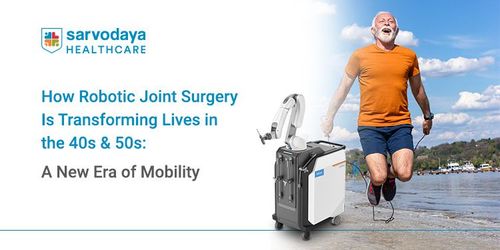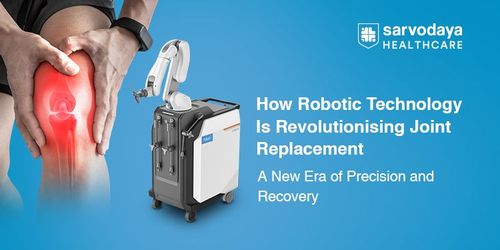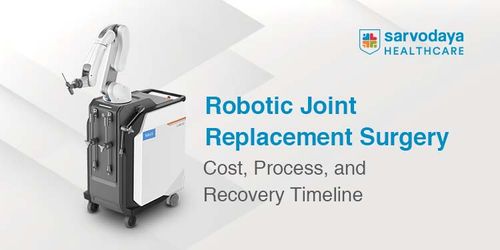Joint pain is not only physically debilitating but can also erode a person’s confidence, daily function and mental well-being. For many, joint replacement surgery becomes a crucial step towards restoring mobility and comfort. However, a growing concern among patients and surgeons alike is the risk of requiring a second operation, often due to complications or early implant failure. This is where the promise of robotic joint replacement becomes incredibly relevant.
In this blog, we explore how this advanced surgical technique contributes to the prevention of revision surgery, increases the success rate of robotic joint replacements, and supports the use of long-lasting implants.
Understanding Robotic Joint Replacement Surgery
Robotic joint replacement surgery combines the precision of robotics with the expertise of a skilled surgeon. Unlike traditional methods, this technique enables custom surgical planning and provides enhanced control during the operation. It is particularly helpful in addressing anatomical variations and ensuring better joint alignment, ultimately leading to improved outcomes.
This approach is increasingly available in India, particularly in well-established medical centres. These hospitals are equipped with advanced tools that support detailed pre-operative mapping and intra-operative guidance.
Benefits of Robotic Joint Replacement
Choosing robotic joint replacement is more than just a preference for high-tech tools; it’s a strategic decision to ensure better outcomes, fewer complications, and lasting relief from joint pain.
Here are the key benefits:
- Higher Robotic Joint Success Rate: Improved accuracy reduces the risk of implant failure.
- Fewer Complications: The minimally invasive approach leads to less blood loss and tissue damage.
- Revision Surgery Prevention: Reduced risk of misalignment and implant wear lowers the need for secondary procedures.
- Better Fit for Long-Lasting Implants: Customised placement ensures implants perform as designed.
- Faster Recovery: Shorter hospital stays and quicker rehabilitation.
- Improved Functionality: Better joint alignment means smoother, more natural movement.
Why Traditional Joint Replacements Fail
While joint replacement surgery offers immense relief, not all procedures go as planned. Sometimes, patients experience limited mobility, or even implant failure, leading to the need for a revision joint replacement surgery. These surgeries are more complex and costlier and come with longer recovery periods.
The most common reasons for failure include:
- Poor Alignment: Even a slight deviation during the implant placement can cause premature wear and instability.
- Infection: Post-operative infections can lead to implant loosening or rejection.
- Implant Wear: Repeated stress and movement can break down conventional materials.
- Bone Loss: Over time, the bone surrounding the implant may deteriorate, affecting its support.
Read Blog- Week-by-Week Recovery Guide: Life After Robotic Knee Replacement Surgery
How Robotic Technology Helps Prevent Revision Surgeries
The precision and consistency offered by robotics are unmatched. Robotic joint replacement surgery allows for detailed planning and execution, significantly lowering the chance of misalignment and mechanical failure. This increases the robotic joint success rate and helps avoid the need for corrective procedures in the future.
Here’s how robotic systems contribute to revision surgery prevention:
- Accurate Implant Positioning: The robotic system ensures optimal alignment for each individual’s anatomy.
- Balanced Joint Movement: Robotic tools assess ligament tension in real-time, supporting natural joint motion.
- Minimised Human Error: Real-time feedback and pre-surgical mapping allow surgeons to operate with higher confidence and precision.
- Better Long-Term Outcomes: With improved accuracy, implants are less likely to shift or wear out prematurely, reducing the likelihood of revision joint replacement surgery.
The Role of Long-Lasting Implants in Success
One of the defining advantages of robotic joint replacement is the support it offers for using long-lasting implants. The success of joint replacement isn't solely dependent on surgical technique; implant durability plays a vital role, especially for younger or more active patients.
With robotics, the precision in implant placement reduces stress and wear on the components. This enhances their lifespan significantly. Additionally, newer implants are now made of materials like:
- Highly cross-linked polyethylene, which resists wear
- Ceramic and oxidised zirconium, which offer smoother articulation
- Titanium alloys, which integrate better with bone
When aligned accurately and supported by the body’s natural movement, these long-lasting implants may serve a patient for 15–20 years or more. This reduces the possibility of implant loosening or failure, contributing directly to revision surgery prevention.
Read Blog- Benefits of Robotic Joint Replacement for Seniors and Athletes
Why Choose a Robotic Joint Replacement Surgeon in Noida
While robotic technology is impressive, its success is deeply tied to the hands that operate it. A skilled robotic joint replacement surgeon in Noida can make all the difference in ensuring precise execution, optimal recovery, and long-term comfort.
Here’s why choosing the right expert matters:
- Specialised Training: Not every orthopaedic surgeon is trained in robotic systems. Ensure your surgeon has advanced certification and experience.
- Track Record of Outcomes: Look for someone with a strong history of high robotic joint success rates and low revision rates.
- Patient-Centric Approach: The best surgeons combine advanced tools with customised care, prioritising patient needs and outcomes.
Consulting with a trusted specialist early ensures proper diagnosis and the best possible surgical plan.
Conclusion: Precision Today, Peace of Mind Tomorrow
Living with joint pain affects every aspect of life, from mobility to mental well-being. With greater precision, optimal implant placement, and a higher robotic joint success rate, robotic procedures help patients reclaim control over their lives without the looming fear of additional surgeries.
At Sarvodaya Hospital, Greater Noida West, patients benefit from cutting-edge robotic techniques and expert orthopaedic care that places long-term wellness at the centre of every decision. As a trusted name in robotic knee replacement, Sarvodaya offers advanced surgical options and preventive consultations to ensure each patient receives timely diagnosis and treatment. Their commitment to precision, safety and personalised recovery ensures better outcomes and improved quality of life for every patient.
Whether it’s your first surgery or you’re trying to avoid a second, robotic technology offers a future filled with movement, not limitations. Book a consultative appointment today – for an active, pain-free tomorrow.





